When leaves are falling this autumn, a number of them will be zapped from the rails by an on-board laser system. TU researchers will test its effectivity.
When the leaves fall, the problems start. Wind or turbulence deposit leaves on the rails where they are compacted by passing steel wheels into a hard black shiny and Teflon-like substance. This layer becomes extremely slippery when wet, making it difficult for trains to slow down and stop. Braking distances double to 800 meters, explains TU railway professor Rolf Dollevoet (CEGS faculty).
“Lots of methods have been tried to clean the organic layer from the rails”, says Dollevoet. “Brushing, grinding, ice jets, water jets. You name it. And most recently: laser pulses.”


A DM-90 train equipped with infrared lasers will perform a field test on the Dutch railways this fall. Together with professor Dirk Schipper’s team from Twente university TU researchers from Delft have developed a life-sized device to measure the friction between wheels and rails (a tribometer). It will measure the effectivity of the laser cleaning.
The on-board tribometer consists of a ‘bogie’ carrying two axis and four wheels. A sort of antilock braking system (ABS) is applied on the rear set of wheels until they start to slip. From the maximal breaking force, the friction from the rails can be derived.
Laser cleaning of rails was invented in the early 2000’s by former British navy man Malcolm Higgins. He patented the idea in 1999 and did his first tests around 2002. The principle worked – dirt and moist were vaporized from the track – but only at very moderate speeds (up to 10 km/hour).
Higgins firm LaserThor contacted the German Fraunhofer institute in Munich and later the Rofin-Sinar laser company in Hamburg to develop a real powerful laser. Railway-technology.com reports that the monster they created (a neodymium yttrium aluminium garnet of Nd:YAG laser) produces 2 kilowatts of infrared radiation in 25.000 pulses per second. The pulses instantly heat the leafy mulch to 5.000 degrees making it simply pop off the rails. A test by Network Rail in the United Kingdom revealed it was successful up until 65 km/hour.
The Dutch field test will be performed by NS, Prorail and Strukton Rail. Details on the number of lasers and the power involved are considered confidential.
“The question is not so much whether the laser system works, but for how long the rails will remain clean”, explains Dollevoet. “We’ll measure the remaining friction over time during rain, drizzle, frost and snowfall. From these measurements NS and Prorail can derive at what frequency the 6.000 kilometres of track need to be lasered and how many trains have to be equipped with lasers to achieve that.”
The measurement results will be handed to the clients by December.



Comments are closed.